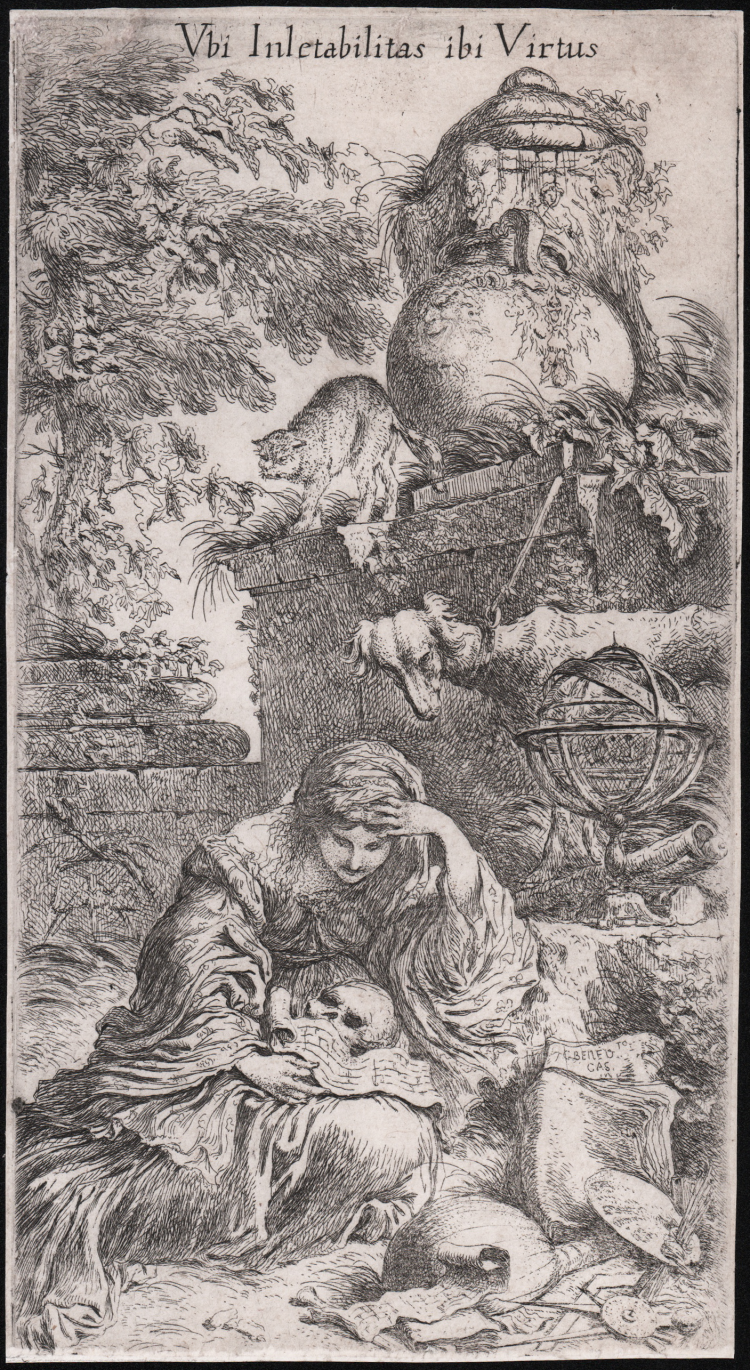




| Reference: | S47058 |
| Author | Giovanni Benedetto CASTIGLIONE detto "Il Grechetto" |
| Year: | 1645 ca. |
| Measures: | 115 x 215 mm |



| Reference: | S47058 |
| Author | Giovanni Benedetto CASTIGLIONE detto "Il Grechetto" |
| Year: | 1645 ca. |
| Measures: | 115 x 215 mm |
Melancholia; a woman seated on the ground with a skull, celestial globe, cat, tomb and a painter's palette.
Etching, circa 1645/47, signed at lower right.
Example of the second state, with motto engraved along the top 'Ubi inletabilitas ibi Virtus', missing the imprint 'Si stampano in Roma per Gio. Dom. Rossi alla Pace all'Insegna di Parigi. Con licenza de' Superiori' at the bottom.
A good impression, printed on contemporary laid paper without watermark, trimmed to the platemark on three sides, inside the platemark at the bottom, where De Rossi's imprint was cut, in good condition.
Rightly considered the most famous engraving of allegorical subject matter in all of seventeenth-century Italy, Castiglione's female depiction of Melancholy symbolizes both meditation and the contemplative life, as well as the theme of the vanity of human activities and memento mori. The artist is clearly inspired by Dürer's Melancholia, depicted as a seated woman surrounded by geometric instruments, the personification of the contemplative life, and he seems not to be unaware of Parmigianino's so-called Astrologia, which is very similar in iconographic setting and permeated with magical meanings (cf. E. Panofsky-F. Saxl, Dürers Melancolia I, Leipzig 1923, p. 64 ff.). This sixteenth-century interpretation of Melancholia is taken up and modified in the seventeenth century by Domenico Fetti, who in his painting depicting Mary Magdalene in the Gallerie dell'Accademia in Venice sticks to the older iconography but translating it into a moralizing allegory of the vanity of human endeavors, fatally destroyed by death and time. In his etching, Castiglione takes up Fetti's allegory, emphasizing even more overtly its moralising aspect with the addition in the second state of the Latin phrase: Ubi Inlaetabilitas ibi Virtus, which is to be interpreted in the Stoic sense that only through sadness is virtue achieved.
The attributes surrounding the figure of the woman also emphasize this cathartic sense of Melancholy. They refer as much to scientific activity the celestial globe, compasses and squares as they do to intellectual and artistic activity - books and scrolls, various sheets, palettes and brushes - with particular emphasis on music, symbolized by the presence of sheet music, a lute and a flute. Over all these symbols of the achievements of human intellect dominates the presence of the skull, placed in the woman's lap, which stands for the presence of death in all of man's life, and therefore the vanity of all his attempts at glory.
Executed in its full maturity, and in particular during the artist's Genoese sojourn before his departure in 1647, the engraving was taken up by Salvator Rosa in his Democritus, which emphasizes, beyond iconographic quotations, the same sense of the transience and decadence of earthly things.
Bibliografia
Bartsch / Le Peintre graveur (XXI.24.26); Bellini 1982 / L'Opera incisa di Giovanni Benedetto Castiglione (15.IV); Ann Percy, 'Giovanni Benedetto Castiglione', Philadelphia 1971, cat. E14; Massari, Tra mito e allegoria, pp. 410-411, n. 154.
Giovanni Benedetto CASTIGLIONE detto "Il Grechetto" (Genova 1616 - Mantova 1670)
|
His origin and his edication in Genua led Castiglione to make acquaitance with the Flemish painting, especially through Jaan Roos e Van Dyck from whom he took the warm, vibrating chromatism.
He lived in Rome from 1632 to 1635 and from 1647 to 1651; among the two periods in Rome, he lived in Naples and he also started studying the intellectualistic classicism of Poussin.
His favourite subjects, both in painting and engraving, were taken from the classical moralism of Stoicism, very typical in Poussin, which enabled him to create his own peculiar repertoire, much more refined in comparison with contemporary artists.
He spent his last working years in Mantua, at the Duke’s Palace; the production of this period enhances his chromatism and the visionary elements of his previous production.
Castiglione has been a silful engraver; he loved this particular art for he thought it was the main mean to widespread his iconography. He was the first, in Italy, to appreciate and imitate Rembrandt.
|
Giovanni Benedetto CASTIGLIONE detto "Il Grechetto" (Genova 1616 - Mantova 1670)
|
His origin and his edication in Genua led Castiglione to make acquaitance with the Flemish painting, especially through Jaan Roos e Van Dyck from whom he took the warm, vibrating chromatism.
He lived in Rome from 1632 to 1635 and from 1647 to 1651; among the two periods in Rome, he lived in Naples and he also started studying the intellectualistic classicism of Poussin.
His favourite subjects, both in painting and engraving, were taken from the classical moralism of Stoicism, very typical in Poussin, which enabled him to create his own peculiar repertoire, much more refined in comparison with contemporary artists.
He spent his last working years in Mantua, at the Duke’s Palace; the production of this period enhances his chromatism and the visionary elements of his previous production.
Castiglione has been a silful engraver; he loved this particular art for he thought it was the main mean to widespread his iconography. He was the first, in Italy, to appreciate and imitate Rembrandt.
|